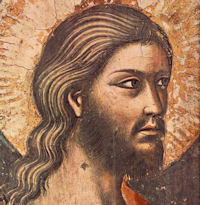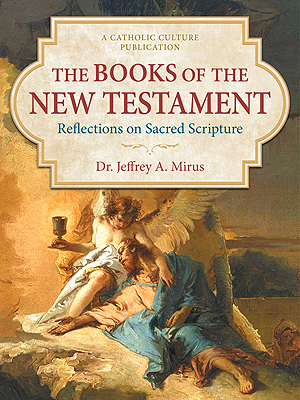Advent: December 20th
Saturday of the Third Week of Advent
Other Commemorations: St. Dominic of Silos, Abbot (RM); St. Zephyrinus, Pope and Martyr (RM) ; Other Titles: Day 4 O Antiphons: O Clavis David (O Key of David)
» Enjoy our Liturgical Seasons series of e-books!
Today is the fourth of the O Antiphons. O sublime majesty of the coming Redeemer! To Him has been delivered the key, the government of the house of David (Is 22:22). Boundless is His power over the graces and privileges of the Church, over the souls and hearts and the wills of men. He holds the destiny of the Church in the palm of His hand. He is Master of the storms that arise to destroy the Church and the souls committed to her. He is capable of dealing with the false principles and the errors that threaten her doctrines. He has overcome the devil and his associates, the world, the flesh and its tribulations. To Him all power is given (Matt. 28:18). "He shall open and none shall shut" (Is 22:22). Against the power that is His all other forces are powerless. The destiny of souls and the government of the Church are placed in His hand. He is the Lord of all. O Key of David, I believe in Thy power; and in the many difficult situations that confront the Church and my own soul, I place my trust in Thee.
O Key of David
"Come, lead the captives from their prison." With the key of His almighty power, the Redeemer has opened the prison in which poor, sinful man was languishing in darkness and in the shadow of death.
Key of David, come and deliver the captives from their prison. The Church wishes that by the practice of virtue we should free ourselves from sin and unfaithfulness. She asks God that He may spare us from punishment, deliver us from His wrath, from an evil death, and from hell. The Church prays that God may free us from a heart that clings to the world, from a spirit that is pleased with worldliness, from a human respect that degrades us. She urges us to return kindness and affection for scorn, love and compassion for persecution. Our Holy Mother the Church prays that we may be delivered from ourselves, from our self-love, and from all our secret sins. She prays that God may detach our hearts from all that can bind them to earth, for he who has been freed from the things of the earth is free with the freedom of Christ.
Key of David, come and deliver the captives from their prison. By Thy coming free us from all that separates us from God. Bring us freedom and redemption; incline us to surrender ourselves completely to God. So all pray for each, and each for all.
Excerpted from The Light of the World by Benedict Baur, O.S.B.
 4th O Antiphon:
4th O Antiphon:
And scepter of the house of Israel,
Thou openest and no man dare shut,
Thou shuttest and no man dare open,
COME
Lead from prison, the fettered one,
The dweller in darkness and the shadow of death.
![]() Today is Day Five of the Christmas Novena.
Today is Day Five of the Christmas Novena.
![]() Today is Day Five of the Christmas Novena
Today is Day Five of the Christmas Novena
St. Dominic of Silos
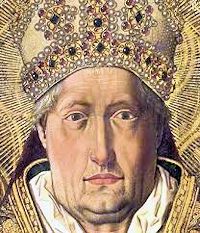 St. Dominic of Silos was defender of the faith. Born in Canas, Navarre, Spain, circa 1000, he entered the Benedictines at San Millan de Ia Cogolla. King Garcia III of Navarre challenged him when he became abbot of the monastery, and Dominic refused to surrender part of the Benedictine lands to the crown. For this he was exiled, going to King Ferdinand I of Castile and Leon, who made him abbot of St. Sebastian Abbey at Silos, now called St. Dominic's.
St. Dominic of Silos was defender of the faith. Born in Canas, Navarre, Spain, circa 1000, he entered the Benedictines at San Millan de Ia Cogolla. King Garcia III of Navarre challenged him when he became abbot of the monastery, and Dominic refused to surrender part of the Benedictine lands to the crown. For this he was exiled, going to King Ferdinand I of Castile and Leon, who made him abbot of St. Sebastian Abbey at Silos, now called St. Dominic's.
Dominic reformed the abbey, built the cloisters in Romanesque style, and started a scriptorium that became famous throughout the region. One of the most beloved saints in Spain, Dominic also rescued Christian slaves from the Moors.
Dominic's shrine is noted for its place in the birth of Dominic de Guzman, the founder of the Order of Preachers. Dominic de Guzman's mother begged for a child there. Dominic was also noted for miracles of healing.
—Excerpted from Evangelizo.org 2001-2014
Patronage: against hydrophobia; against insects; against mad dogs; against rabies; captives; pregnant women; prisoners; shepherds
Symbols and Representation: abbot surrounded by the Seven Virtues; chains, referring to prisoners and slaves; mitered abbot enthroned with a book, a veil tied to his crozier
Highlights and Things to Do:
- Read more about St. Dominic of Silos:
- Read about the connection about St. Dominic and the hounds to St. Dominic of Silos.
- See his depiction of Saint Dominic of Silos enthroned as a Bishop by Bartolome Bermejo.
- If St. Dominic's name is familiar, it might be because of the "Chant" album by the Benedictine Monks of Santo Domingo de Silos album. It peaked as Number 3 on the Billboard charts in 1994. Read how Gregorian Chant is the voice of the Church.
St. Zephyrinus
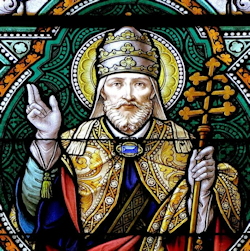 Commodus, looked favorably on the Christians at the onset of his reign. His son Caracalla had been raised by a Christian nurse, and the emperor himself had been cured of some ailment by a Christian. However, Severus later reversed his position toward the Christians, probably due to their unpopularity with the Roman pagans, and he issued a decree forbidding any person to become either a Jew or a Christian. The persecution commenced once again.
Commodus, looked favorably on the Christians at the onset of his reign. His son Caracalla had been raised by a Christian nurse, and the emperor himself had been cured of some ailment by a Christian. However, Severus later reversed his position toward the Christians, probably due to their unpopularity with the Roman pagans, and he issued a decree forbidding any person to become either a Jew or a Christian. The persecution commenced once again.
Zephyrinus was a Roman and the son of Habundius. Some sources indicate that his strength did not lie in leadership, but that he depended greatly on the more capable and practiced Calixtus, who, since his release from the labor mines, had been rehabilitated and devoted himself to the Church. Consequently, he was appointed archdeacon. Not only did he direct the lower clergy for Zephyrinus but he was also entrusted with the administration of the official cemetery which the Church now owned.
Heresy stormed the Church from all sides, but Zephyrinus adhered firmly to the doctrine set forth by the apostles. The excommunicated tanner Theodotus continued to teach that Christ was not the true Son of God. He had even gone so far as to set up his own church and place a paid bishop in residence. This bishop, called Natalius, had previously been tortured for confessing the true faith. According to legend, angels were sent to Natalius in visions to rebuke him for joining Theodotus, since Jesus did not want anyone who had suffered for Him to be cast out of the Church. Natalius appeared to have seen the light; he threw himself upon the mercy of Zephyrinus and begged to be pardoned. Natalius was readmitted to communion by the bishop of Rome after considerable penance.
Zephyrinus decreed that all ordinations, even those of mere clerics, be performed before the assembled clergy and laity.
Another heresy, called Modalism, taught by Praxeas, Noetus, and Sabellius, was brought to the attention of Zephyrinus. Followers of this theory obliterated the distinctions between the entities of the Trinity. Zephyrinus immediately condemned this, again citing the original teachings of the apostles.
Zephyrinus was said to have been martyred and was buried in his own cemetery on the Appian Way.
—Excerpted from The Popes: A Papal History, J.V. Bartlett
Symbols and Representation: Monstrance; triple cross.
Highlights and Things to Do:
- Read more about St. Zephyrinus:
- Pray this prayer for the feast of St. Zephyrinus.
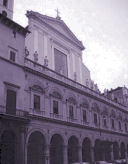 Ember Friday of Advent
Ember Friday of AdventStation ad Santi Dodici Apostoli, also Santi Apostoli (Station at the Twelve Holy Apostles):
The stational church for today's Mass is the church of the Twelve Apostles in Rome. Mary is the apostle of the liturgy, the Mediatrix of all grace. She is the root from which springs the full bloom, Christ. "And of His fullness we all have received, and grace for grace" (John 1:16). It was erected by Julius I (337-352) over the barracks of ancient Rome's firemen and entrusted since 1463 to the Conventual Franciscans. Originally dedicated to the Apostles St. James and St. Philip, it was rededicated to all the Apostles in the 16th century. It is currently in the care of Conventual Franciscans.
For more on Santi Dodici Apostoli, see:
For further information on the Station Churches, see The Stational Church.




